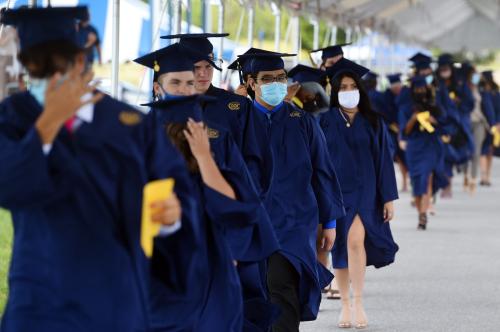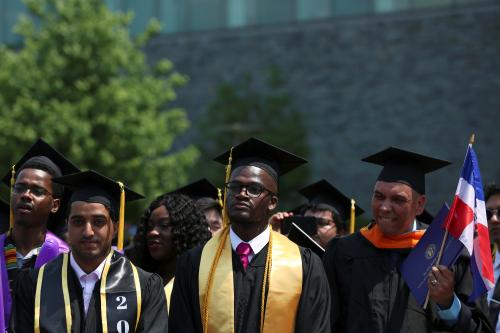Student-loan debt is top of mind for many Americans these days. Americans cumulatively owe about $1.75 trillion in student loans, and federal loans account for about 93% of that total. The potential for debt cancellation, which has been floated by many policymakers, economists, and student advocates, could help provide life-changing economic relief for millions of U.S. households.
Discussions of debt cancellation, as well as of free tuition and other proposals to make college more accessible, are fundamentally a question of responsibility. Should individuals, such as students and their parents, be on their own in paying for higher education, or should the government assume some or all of this responsibility? Americans have grappled with the notion of responsibility for college costs for decades. We see this in television segments about whether and how parents should pay for their children’s college; in advice columns asking how much is too much when it comes to spending on tuition; in films when the main characters wonder how they will ever pay for their degrees.
These discussions and portrayals ultimately ask who should be responsible for the funding of college. We have heard from the media, pop culture, scholars, and policymakers on this basic question. But where does the public stand?
Over the past decade, we along with our research team have conducted telephone interviews with American adults to gauge public opinion on the funding of college. We worked with the Center for Survey Research at Indiana University to interview a nationally representative sample of about 1,600 respondents, and we incorporated both closed- and open-ended questions that capture multiple data points on this issue. These responses are reported in our new book, “Who Should Pay? Higher Education, Responsibility, and the Public,” published by the Russell Sage Foundation. In our interviews, we begin with two simple questions. The first question is who should have the main responsibility for the cost of education beyond high school—whether it should be students, parents, the federal government, or the state or local government. The second question is who should have the second-most responsibility, given these same response options.
Looking at the answers to these questions side by side gives us a sense of how people think about the issue of responsibility. Some people are individualists. They think that parents and students should pay for college with few contributions from the government. Others are collectivists. They think that the federal and state or local governments should bear most of the responsibility for college, with less reliance on individual funds. Others still advocate for a shared responsibility, in which individuals and government act as partners—parents and students shoulder some of the cost, and government pays some as well.
What we found initially was quite clear: When we started conducting our interviews in 2010, Americans overwhelmingly believed that parents and students should pay for college, at approximately two-thirds (65%) of the sample. This made sense to us. Americans are individualistic at their core, and the notion of parental funding for college is baked into financial-aid forms. When one of us conducted similar analyses of federal data from the 1980s, the same pattern was evident. The American preference for individualism looked rock-solid over a period of decades, and we assumed that it would not change.
But starting in 2015, and in the years since, we have documented a dramatic shift in how Americans answer these questions, as shown in Figure 1. In interviews from 2015, the public was evenly split (at 50% each) between those who prefer an individualist solution (on the left) and those who say that government should have the most or second-most responsibility for the funding of college (combining the three response combinations on the right). Note that these changes in public opinion occurred despite our using similar, nationally representative samples in both surveys, as well as identical question wordings.
A recent national online survey that we fielded in 2019 with over 1,200 Americans suggests a continuing realignment in public opinion toward collective or shared responsibility. Our surveys also show that these views map closely with opinion regarding free community college and/or free tuition at public universities.
These data represent a massive shift in public opinion in a very short period of time. Social scientists have made a convincing case that public opinion, as a general rule, is very slow to change. Some social scientists have even made the argument that people generally do not change their opinions about social issues; instead, many changes in public opinion are attributable to older generations dying off and being replaced by those with more progressive attitudes (a phenomenon referred to as “cohort replacement”). Our interviews, however, suggest a fundamental shift in public opinion regarding the funding of college.
The words of our interviewees help pinpoint some of the factors behind the change. In the 2010s, Americans faced so many challenges in paying for college—including high college costs, staggering student debt, the lingering economic fallout from the recession, and rising inequality, to list just a few issues that our respondents cited in their interviews—that the public is now more supportive of government responsibility than ever before. This was also a period when we saw expanded government coverage of health insurance through the Affordable Care Act (ACA) of 2010. In fact, several interviewees brought up the ACA as an example of how the government should be involved in bread-and-butter issues that affect people’s daily lives. The increasing shift in health care from an individualist approach to a more collectivist approach—and the accompanying discussion of health care as a right (versus a privilege)—may have been carried over to affect people’s beliefs about higher education.
As we noted, the public is about evenly split between those who do and do not want the government to bear responsibility for the funding of college. Some people may see this 50/50 split and bemoan the polarization of America on yet another contentious social issue. But we see this polarization as an encouraging sign of social change. The dramatic and swift change in public opinion regarding same-sex marriage is a useful parallel. Data from the General Social Survey, the gold standard for survey research, show that less than one-third (31%) of all Americans supported same-sex marriage in 2004. By 2010, Americans were approximately split down the middle in their support and opposition toward same-sex marriage. (Note that these numbers are a mirror image of what we find regarding the funding of college). By 2018, support for same-sex marriage increased to more than two-thirds (68%). Over this time period, Americans shifted rapidly from a more conservative consensus, to a state of polarization, until finally coalescing around a more progressive consensus.
Given the tenor of debates over debt cancellation and free tuition, it seems that public opinion on the funding of college may be trending in a similar direction. Americans want college to be more affordable, and they want government to contribute much more substantially to these costs.







Commentary
Responsibility for the funding of college: Where does the public stand?
April 14, 2022